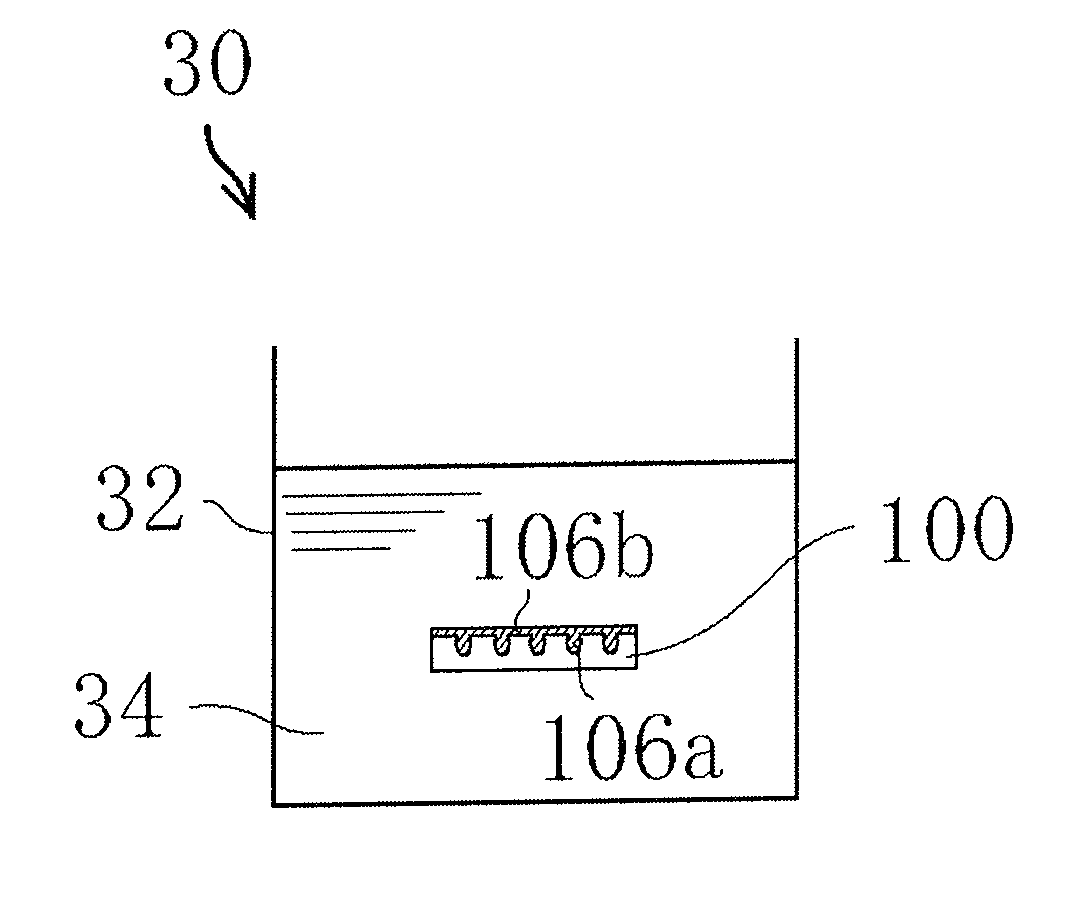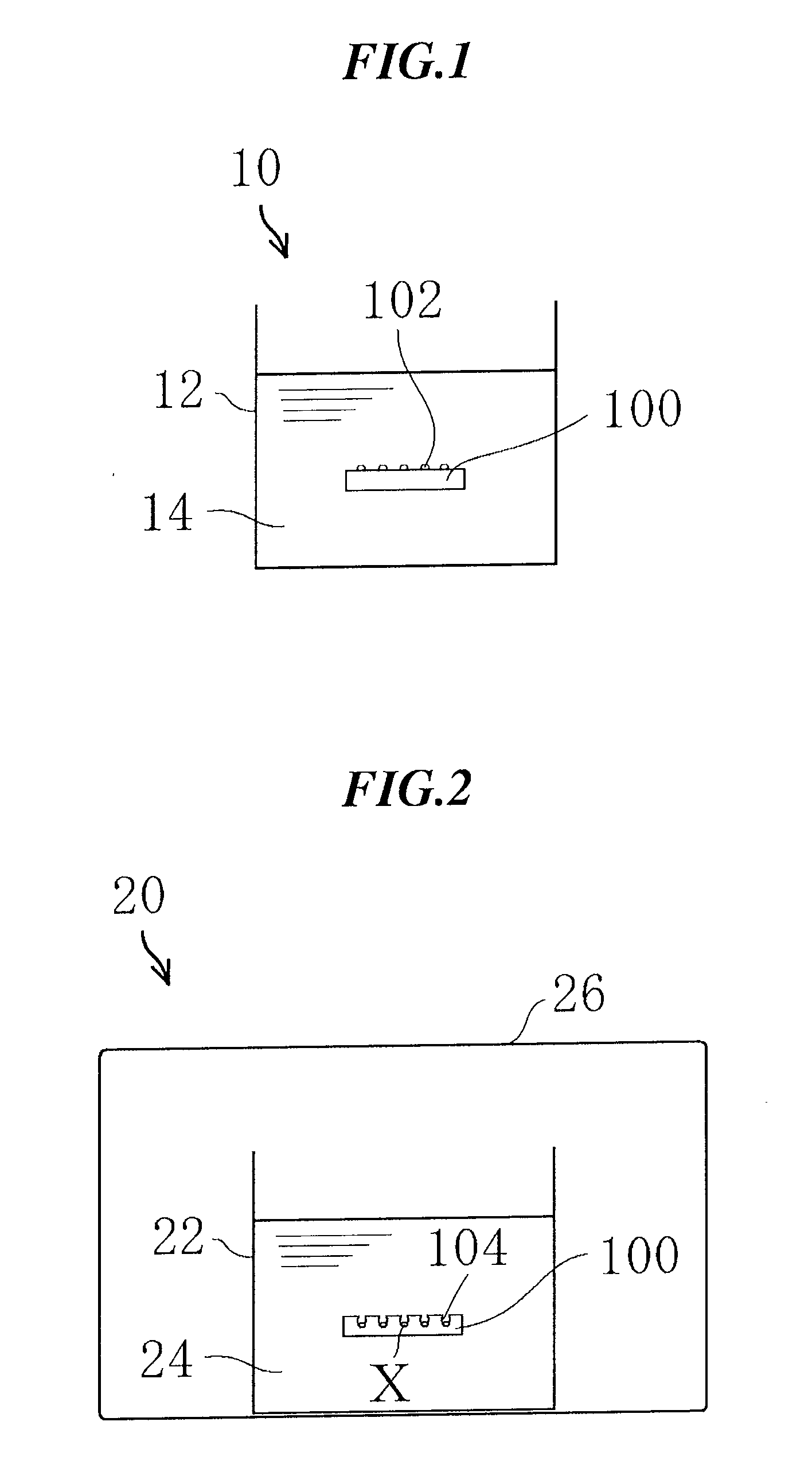Compound material, method of producing the same and apparatus for producing the same
a technology of compound material and method, which is applied in the direction of liquid/solution decomposition chemical coating, transportation and packaging, coatings, etc., can solve the problems of poor adhesion of silicon with a plated metal, insufficient adhesive of metal or the like formed by plating as described above, etc., to achieve precise filling of pores, improve adhesion, and less voids
- Summary
- Abstract
- Description
- Claims
- Application Information
AI Technical Summary
Benefits of technology
Problems solved by technology
Method used
Image
Examples
first embodiment
[0047]Described in the present embodiment are a composite material and a method of producing the same. FIG. 1 is a diagram illustrating a dispersion / allocation device 10 for dispersing and allocating a first metal on a surface of a silicon substrate 100, which serves as a matrix, according to the present embodiment. FIG. 2 is a diagram illustrating a non-penetrating pore forming device 20 for forming non-penetrating pores in the surface of the silicon substrate 100. FIG. 3 is a diagram illustrating a plating device 30 for filling in the non-penetrating pores a second metal or an alloy of the second metal and forming on the surface of the silicon substrate 100 a film or a layer of the second metal or an alloy of the second metal (hereinafter, selectively referred to as a “layer” for the purpose of easier description). The present embodiment adopts silver (Ag) as the first metal and cobalt (Co) as the second metal or an alloy of the second metal.
[0048]As shown in FIG. 1, in the presen...
second embodiment
[0060]Described in the present embodiment are another composite material and a method of producing the same. The method of producing the composite material according to the present embodiment is same as that of the first embodiment except for some conditions. Therefore, the description redundant with that of the first embodiment may not be repeatedly provided. A first metal 102 in the present embodiment is dispersed and allocated into the shapes of particles or islands when a silicon substrate is immersed in a first solution 14. However, in the present embodiment, such shapes are selectively referred to as “particles” for the purpose of easier description.
[0061]In the present embodiment, particles of silver (Ag) as the first metal 102 were dispersed and allocated on the surface of a silicon substrate 100, which serves as a matrix, with use of a dispersion / allocation device 10 configured as shown in FIG. 1. More specifically, the present embodiment adopts as the first solution 14 an ...
third embodiment
[0069]Described in the present embodiment are a different composite material and a method of producing the same. The method of producing the composite material according to the present embodiment is same as that of the first embodiment except for the matrix thereof. Therefore, the description redundant with that of the first embodiment may not be repeatedly provided. A first metal 302 in the present embodiment is dispersed and allocated into the shapes of particles or islands when the matrix is immersed in a first solution 14. However, in the present embodiment, such shapes are selectively referred to as “particles” for the purpose of easier description.
[0070]The present embodiment adopts a polycrystalline silicon substrate 300 as a matrix thereof. Again in the present embodiment, the first metal 302 of silver (Ag) was dispersed and allocated on the surface of the polycrystalline silicon substrate, which serves as the matrix, with use of a dispersion / allocation device 10 configured ...
PUM
| Property | Measurement | Unit |
|---|---|---|
| diameters | aaaaa | aaaaa |
| thick | aaaaa | aaaaa |
| depth | aaaaa | aaaaa |
Abstract
Description
Claims
Application Information
 Login to View More
Login to View More - R&D
- Intellectual Property
- Life Sciences
- Materials
- Tech Scout
- Unparalleled Data Quality
- Higher Quality Content
- 60% Fewer Hallucinations
Browse by: Latest US Patents, China's latest patents, Technical Efficacy Thesaurus, Application Domain, Technology Topic, Popular Technical Reports.
© 2025 PatSnap. All rights reserved.Legal|Privacy policy|Modern Slavery Act Transparency Statement|Sitemap|About US| Contact US: help@patsnap.com



